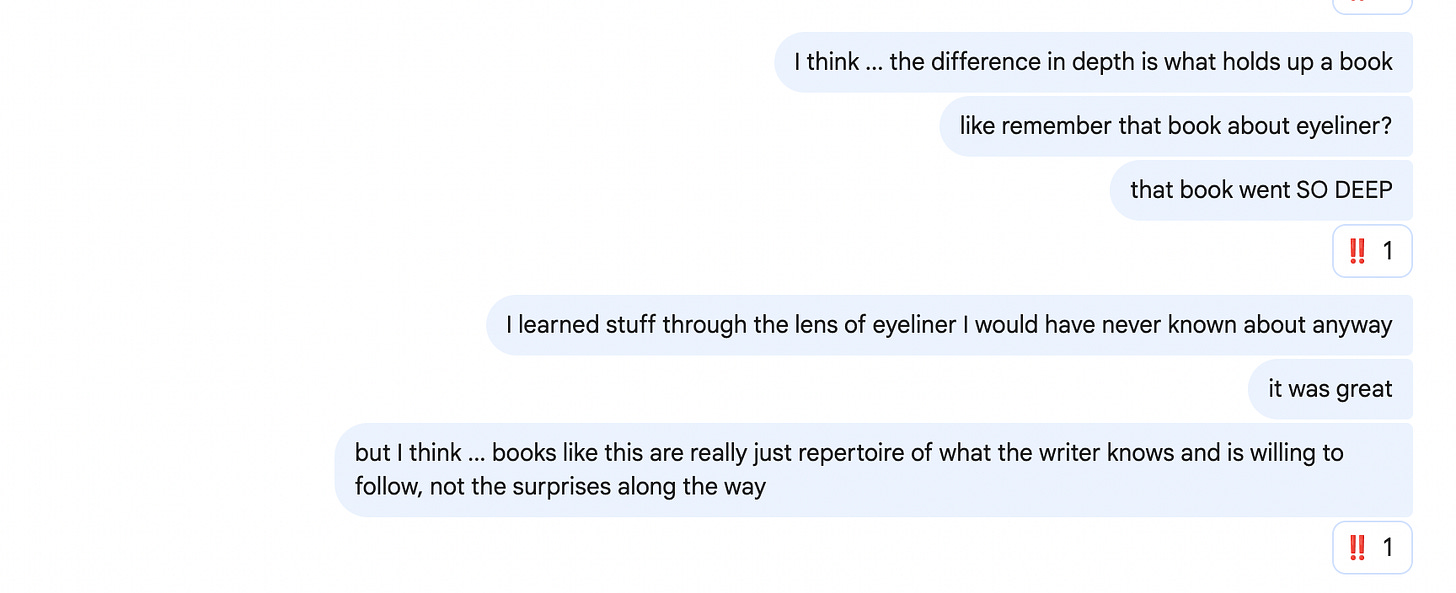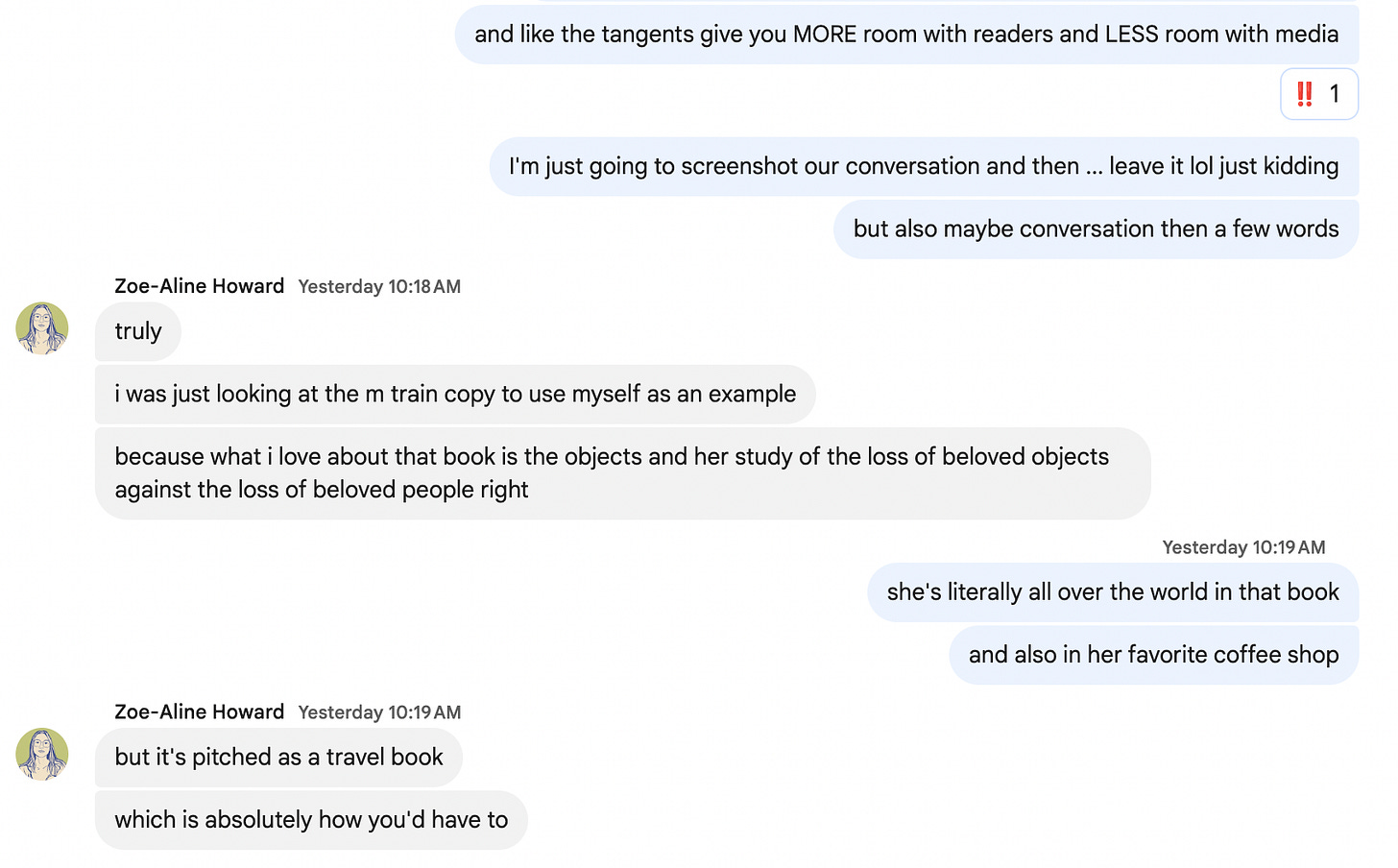THE GET-READY-WITH-ME-ICATION OF BOOKS
if you can explain this book in a get-ready-with-me video, it's a headline book. If not, well ... here's a newsletter.
I’m just going to come out and say the point, and then I’ll back track. Editors buy headline books. Books that sell (nonfiction) and I would argue now — fiction too in certain ways — are easy to distill into a headline. It’s a burden to the headline for a book to be complicated, tangential, or even deep. I know a lot of people just reared back at deep as if I’m being judgmental and TBH maybe I am, but it costs money to do deep research, it costs money to travel to many different archives, and it costs money to do the level of work and analysis that goes beyond the “surface” and digs beyond want can be found in the internet archive. Publishers are not paying for that research as of late (though traditionally this was the whole point of selling a book on proposal) which means more books are suffering the surface-level. Those paid for depth (and therefore a bet on wide readership reach) are getting “significant deals,” the rest of us have to travel to the Harry Ransom Center ourselves.
There’s a very popular book I’m seeing all over Substack (Zoe and I would pay money to see the proposal for this one), with an author that has a pretty large platform. So, perhaps platform sold the book. But as I got on my little complaint high horse in Google chat with Zoe and whined that I wasn’t sure what the book was ACTUALLY about even though I’ve seen it everywhere (and the cover everywhere with title + subtitle explaining it’s “aboutness”), I still am lost as to … the point?
And that’s because it’s a headline book. I have not read it (so grain of salt over my shoulder), but Goodreads reviews keep saying that it’s very repetitive. That is a sign to me that the research doesn’t have enough breadth and depth. That the points need more turtles all the way down—that the argument hasn’t reached its reaches.
As Zoe puts it here: there’s the media headline (imagine it the length of a “get ready with me” video) and then there’s the actual book, which is you talking for an hour with your friends about what you’re writing at a coffee shop.
But, BUT, it’s everywhere because of platform AND because media likes headline books (they’re easy!), and readers like depth. The headline or idea is the way INTO the book, but readers stay for the surprise, the side quests, the research, and writing. I don’t believe readers actually want the trite and trivial when they pick up a nonfiction book about IDEA, I believe they want to be (lacking a word here) spanned—across time and place, people and cultures, fact and folklore. The problem is, often books that do that harder work, are also harder to whittle down to a headline.
So, publicists pull strands, like we’re working a loom. We try to glob one of the books strands to a contemporary cultural moment (or a clash with a cultural moment), we try to unweave the book nightly (heyyyy, Penelope) so that we can find the trap doors for media, the reason to take on the whole from one kernal of the cob. I am all over the place in my metaphors today (I may or may not have a fever). We collaborate with authors to come up with “talking points” and strands that they can write into (companion essays) that are parallel to the book, but perhaps not IN the book.
As an example, check out these talking points for Nicole Graev Lipson’s Mothers and Other Fictional Characters (which is out in two weeks!). It’s a memoir-in-essays and so it spans many ideas from one central beating heart—mothers are thinkers. I also love Hyeseung Song’s talking points for Docile. Thinking about your own talking points will get you closer to transforming the ideas in your book to headlines, which will get you closer to pitches that might work for your book. I dare to say that you have to do this for your book.
What we ultimately came to in our conversation about this, Zoe and I, is that the headline and the talking points and the get-ready-with-me are TALKING AT / (TO) people about the ideas in the book, and the book is about engaging WITH the ideas.
The difference is: a headline, a sort of flat argument or point, and a book, it’s round—it’s earth is not flat. This is why sometimes when you read a book you think, this could have been an article or essay. There’s simply not enough meat to it. And yet, media likes bites. The Big Idea Book Club has lots and lots of lists from authors on the bite-size points of their book. Here’s one for Raising a Rare Girl (I was looking at this book yesterday as a comp for another book).
These bite-size pieces are talking points, headlines, essay ideas. They do, in my opinion, flatten the ideas in the book a little bit, but that’s what MEDIA wants—digestible. The conversation that comes from your digestible pitch / headline can be nuanced, complicated, interesting, surprising, but to get to that part, you need the headline. Your corkscrew of a book, digging deep into the earth’s core (I’m freaked out by all the news that the core is transforming—can you tell?) is not what an editor at a magazine wants in a pitch. They want a couple paragraphs on a bite size idea, the point behind a headline, or even better the story behind a headline. Not necessarily a less savvy idea, just a smaller chunk of it.
Anyway, this is all to say—to get a bigger platform, you have to think in smaller pieces.
As always, the Pine State calendar of events lives here, and you can buy our books here! You can also see what we’re working on and contact us through our website, Pinestatepublicity.com.
Coming soon (in MARCH!) to a shelf near you:
Mothers and Other Fictional Characters | March 4
Big Money Porno Mommy | March
No Small Thing | March 15
ICYMI: Mothers and Other Fictional Characters got a “stunning” and “sparkling” review from Joan Frank in San Francisco Chronicle yesterday, Jehanne Dubrow’s essay on a friendship ghosted in The Conversationalist is a must-read!, and so much more on our Twitter & Instagram.








Love this look at what is gained (a publication deal! press!) and what is lost (nuance!) when you turn your book into a bite-sized idea. It's a catch-22, isn't it? What are those of us who are querying supposed to do? We debut authors have to figure out how to sell our books somehow... to agents, to editors and then to the public. Yikes...
Fascinating as always! Love your insights